Equine Massage: A Practical Guide (15 page)
Read Equine Massage: A Practical Guide Online
Authors: Jean-Pierre Hourdebaigt

Kneading
Kneading is done in a rhythmic, circular motion (small half-circles overlapping one another, pushing outwards) the same way you would knead dough, using the thumbs or the palmar surface of the index finger, middle finger, and ring finger. Contact is maintained at all times.
The tissues are intermittently compressed against the underlying bone structure. To relax a horse, the rhythm should be 1
movement per second; to induce stimulation, increase the rate to around 2 or 3 movements per second. Kneading has a pumping
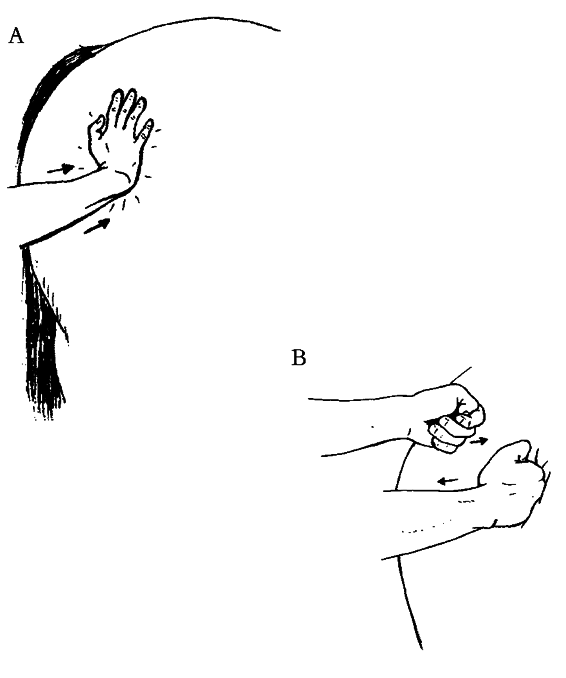
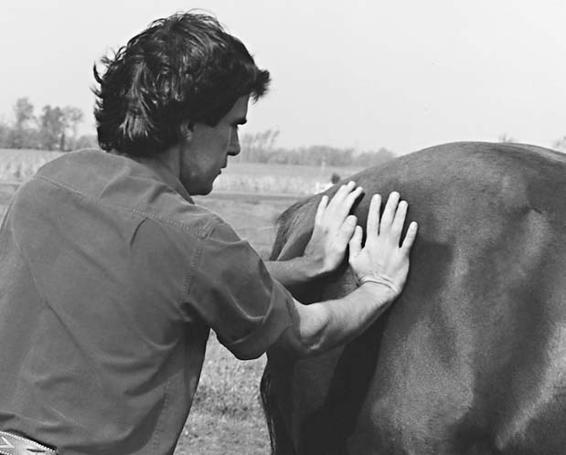
Principles and Concepts of Massage
65
3.10 Petrissage: Compression
Movement
(A) palmar compression
(B) fist compression
3.11 Palmar Compression Movement
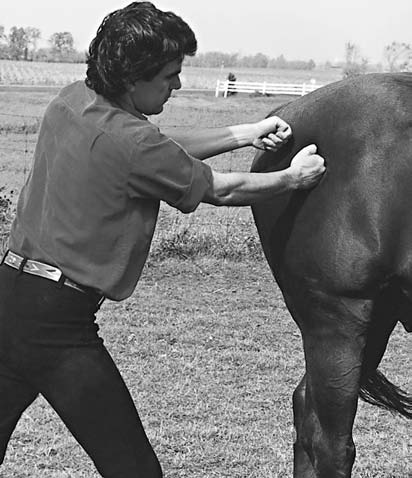
66
Equine Massage
3.12 Fist Compression Movement
effect that boosts circulation and improves oxygenation. It also affects the various bundles of muscle fibers, separating and draining them. Kneading will help you feel scar tissue patches or small spasms (stress points).
Kneading is usually performed with two hands but it may be performed with one hand when the area being treated is small (the flexor tendon, for example).You can try other combinations, using only two fingers or a thumb and finger.When dealing with large areas (the hindquarters, for example), use the palms of your hands in combination with your body weight (proper posture). It is a very efficient technique.
When kneading, gauge your pressure. Start at 2 or 3 pounds.
Increase to between 10 and 15 pounds when working the big muscle groups. Use up to 20 pounds when working on heavy horses. Intersperse your kneadings with a good deal of effleurages every couple of minutes.
Compression
Compression movements are made with the palm of the hand or with a lightly clenched fist, alternating each hand rhythmically and applying pressure directly to the muscle. Compression is used over large, bulky muscle areas, such as the hindquarters or the
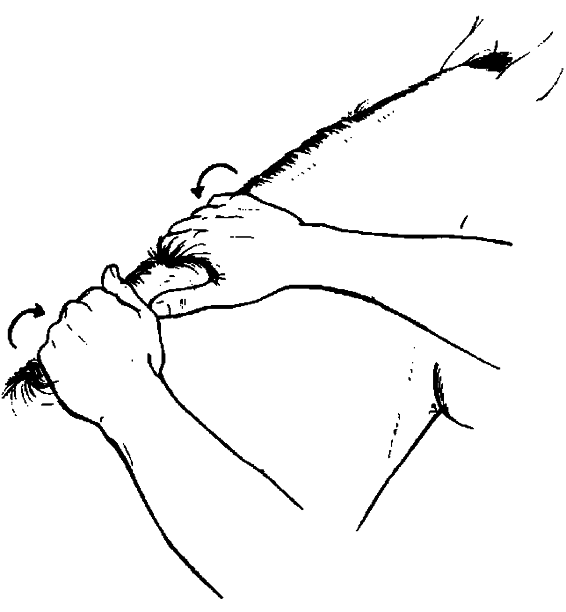

Principles and Concepts of Massage
67
shoulders if well muscled, working from your elbows and applying your body weight. The method is similar to that of kneading but without the gliding movement over the muscles.The rhythm should be 1 compression every second.Any faster would be highly stimulating, almost irritating to most animals. Do not use compression on bony or thinly muscled areas.
Compression complements kneading; it is used to save time and reduce fatigue when working on large muscle groups. Compression produces the same pumping effect and has the same benefits as kneading. Be careful not to over compress the muscles. Gauge your pressure at between 20 and 30 pounds maximum. It is better to repeat the exercise several times and secure the desired effect rather than go too fast or too heavily, which will result in irritated or bruised fibers.
Muscle Squeezing
Muscle squeezing is mostly used to decongest and relax tense muscles, principally along the crest of the neck and on the legs and tail.The movement is made between extended fingers and the heel of the hand, keeping the entire palm surface in full contact with the body part worked on. Take care not to pull the muscle away from its bony support; merely grasp and gently squeeze it.
3.13 Petrissage: Muscle
3.14 Double Hand Muscle
Squeezing Movement
Squeezing Movement
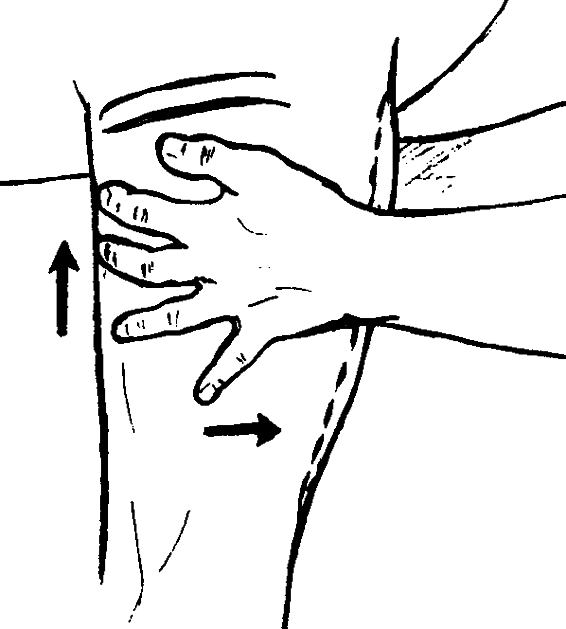
68
Equine Massage
Muscle squeezing accomplishes several things:
❖ The horse responds to the deeply felt touch by relaxing the muscle
❖ It gives you feedback about the tension in the muscle fibers
❖ It increases circulation
Since we only want to relax and decongest, it is not necessary to exert a lot of strength in this move. When muscle squeezing, always start gently with 5 to 10 pounds of pressure.You can use 15 pounds of pressure if dealing with bulkier muscle groups of heavier horses (thicker neck, legs, or pectoral muscles). If there is tenderness in the muscle, squeeze very gently.
Using muscle squeezing in a soothing, slow rhythm (1 squeeze every second) has a strong calming effect on the nervous system.
It is used for this purpose in the relaxing massage routine, over the crest of the neck.
When done in a brisk manner (2 to 3 squeezes per second), muscle squeezing has a very stimulating effect both on the circulation and on the nervous system. The fast pace invigorates the animal. It is a very useful move to warm up such leg muscles as the triceps, the flexors, and extensors during cold weather.
Picking Up
Picking up is a movement done with the palms of both hands, fingers extended. Pressure will be concentrated on the heels of the hands. Grasp the body part between both hands, start to squeeze it gently, and simultaneously lift the muscle away from the bone structure at right angles. Squeeze and let go.Without losing contact, grasp again and repeat the movement. Pressure should be adjusted to the size of the muscle and its level of
tension-tenderness (10 to 15
and eventually up to 20 pounds
with each hand).
As you lift the muscle, feel
for the elasticity of the fibers.
Let them go when you reach
the maximum stretching point.
Don’t overdo it. This manipulation will contribute mostly
to toning the muscle as well as
increasing circulation.
Picking up is used mostly on
the upper forelegs and hind
legs; it is good on the stifle and
3.15 Petrissage: Picking-up
on the crest of the neck as well.
Movement
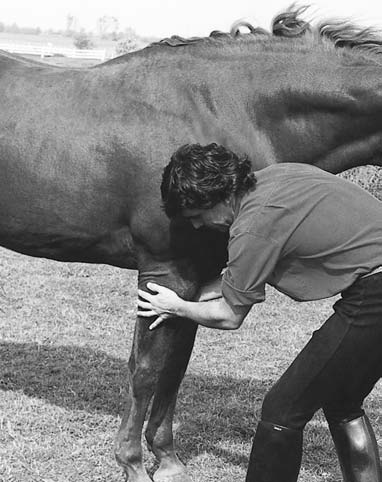
Principles and Concepts of Massage
69
3.16 Picking-up Movement
Done in a very gentle manner, picking up could be included in a relaxing routine when massaging the legs or the neck. But normally it is used in sports massage, in short therapeutic treatments, or in a warm-up routine prior to exercise. If the muscles treated show acute signs of inflammation, do not use this movement. It is too aggressive for this condition.
Wringing
Wringing is a great move to use on the horse’s back, shoulders, and hindquarters. This movement efficiently increases circulation and also is very useful in fighting inflammation over the muscles of the back. It can be used before saddling your horse, but mostly should be used after removing the saddle. Horses love it then!
Wringing is done with the palmar surface of the hand, thumbs extended at a 45-degree angle from the hand. Apply both hands flat on the body part; then start wringing the muscle side to side, almost in the same way you would wring a wet cloth. The muscle is lightly and gently lifted, then wrung side to side.
Wringing is a very efficient way to stimulate circulation and warm up muscles in a short time. This movement can be applied anywhere on the horse’s body. Use an average pressure, starting at about 2 pounds and building to 15 pounds, depending on the
